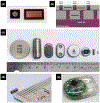Advanced implantable drug delivery technologies: transforming the clinical landscape of therapeutics for chronic diseases
- PMID: 31104136
- PMCID: PMC7161312
- DOI: 10.1007/s10544-019-0389-6
Advanced implantable drug delivery technologies: transforming the clinical landscape of therapeutics for chronic diseases
Abstract
Chronic diseases account for the majority of all deaths worldwide, and their prevalence is expected to escalate in the next 10 years. Because chronic disorders require long-term therapy, the healthcare system must address the needs of an increasing number of patients. The use of new drug administration routes, specifically implantable drug delivery devices, has the potential to reduce treatment-monitoring clinical visits and follow-ups with healthcare providers. Also, implantable drug delivery devices can be designed to maintain drug concentrations in the therapeutic window to achieve controlled, continuous release of therapeutics over extended periods, eliminating the risk of patient non-compliance to oral treatment. A higher local drug concentration can be achieved if the device is implanted in the affected tissue, reducing systemic adverse side effects and decreasing the challenges and discomfort of parenteral treatment. Although implantable drug delivery devices have existed for some time, interest in their therapeutic potential is growing, with a global market expected to reach over $12 billion USD by 2018. This review discusses implantable drug delivery technologies in an advanced stage of development or in clinical use and focuses on the state-of-the-art of reservoir-based implants including pumps, electromechanical systems, and polymers, sites of implantation and side effects, and deployment in developing countries.
Keywords: Implants; Long-acting formulations; MEMS; NEMS; Non-biodegradable polymers.
Conflict of interest statement
Figures











Similar articles
-
Microchips and controlled-release drug reservoirs.Wiley Interdiscip Rev Nanomed Nanobiotechnol. 2010 Jul-Aug;2(4):400-17. doi: 10.1002/wnan.93. Wiley Interdiscip Rev Nanomed Nanobiotechnol. 2010. PMID: 20564466 Review.
-
Synthetic biodegradable polyesters for implantable controlled-release devices.Expert Opin Drug Deliv. 2022 Oct;19(10):1351-1364. doi: 10.1080/17425247.2022.2131768. Epub 2022 Oct 25. Expert Opin Drug Deliv. 2022. PMID: 36197839 Review.
-
Therapeutic applications of implantable drug delivery systems.J Pharmacol Toxicol Methods. 1998 Jul;40(1):1-12. doi: 10.1016/s1056-8719(98)00027-6. J Pharmacol Toxicol Methods. 1998. PMID: 9920528 Review.
-
Application of micro- and nano-electromechanical devices to drug delivery.Pharm Res. 2006 May;23(5):847-63. doi: 10.1007/s11095-006-9906-4. Epub 2006 May 5. Pharm Res. 2006. PMID: 16715375 Review.
-
A review of implantable intravitreal drug delivery technologies for the treatment of posterior segment eye diseases.J Pharm Sci. 2010 May;99(5):2219-39. doi: 10.1002/jps.21987. J Pharm Sci. 2010. PMID: 19894268 Review.
Cited by
-
Subcutaneous Delivery of High-Dose/Volume Biologics: Current Status and Prospect for Future Advancements.Drug Des Devel Ther. 2021 Jan 13;15:159-170. doi: 10.2147/DDDT.S287323. eCollection 2021. Drug Des Devel Ther. 2021. PMID: 33469268 Free PMC article. Review.
-
Formulation, Development, and Characterization of AMB-Based Subcutaneous Implants using PCL and PLGA via Hot-Melt Extrusion.AAPS PharmSciTech. 2024 Dec 17;26(1):16. doi: 10.1208/s12249-024-03004-4. AAPS PharmSciTech. 2024. PMID: 39690379
-
Emerging technologies for local cancer treatment.Adv Ther (Weinh). 2020 Sep;3(9):2000027. doi: 10.1002/adtp.202000027. Epub 2020 Jun 5. Adv Ther (Weinh). 2020. PMID: 33072860 Free PMC article.
-
Viral load Reduction in SHIV-Positive Nonhuman Primates via Long-Acting Subcutaneous Tenofovir Alafenamide Fumarate Release from a Nanofluidic Implant.Pharmaceutics. 2020 Oct 17;12(10):981. doi: 10.3390/pharmaceutics12100981. Pharmaceutics. 2020. PMID: 33080776 Free PMC article.
-
A New Normality Illuminated by Past and Present! A Qualitative Study: Experiences and Challenges of Everyday Life in Patients With Advanced Heart or Lung Failure.Glob Qual Nurs Res. 2022 Nov 29;9:23333936221140374. doi: 10.1177/23333936221140374. eCollection 2022 Jan-Dec. Glob Qual Nurs Res. 2022. PMID: 36467861 Free PMC article.
References
-
- Allen EE, Instrument for transfusion of blood with patent 249,285. 8 November 1881.
-
- Allen RH, Kaunitz AM, Hickey M, in Williams Textb. Endocrinol, 13th edn, ed. by Melmed S, Polonsky KS, Larsen PR, Kronenberg HM. (Elsevier, Philadelphia, 2016), pp. 664–693
-
- Almeida DRP, Chin EK, Mears K, Russell SR, Mahajan VB, Retin. Cases Brief Rep 9, 142 (2015) - PubMed
Publication types
MeSH terms
Substances
Grants and funding
LinkOut - more resources
Full Text Sources
Other Literature Sources
Medical

